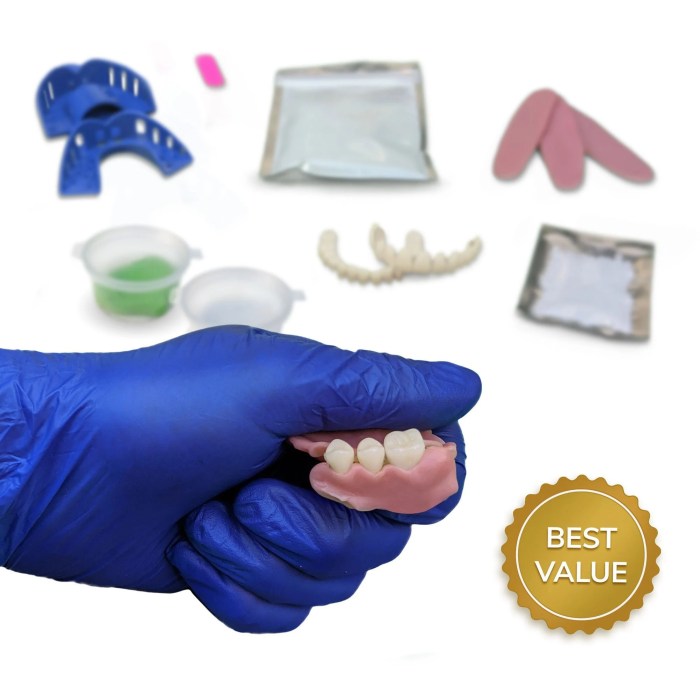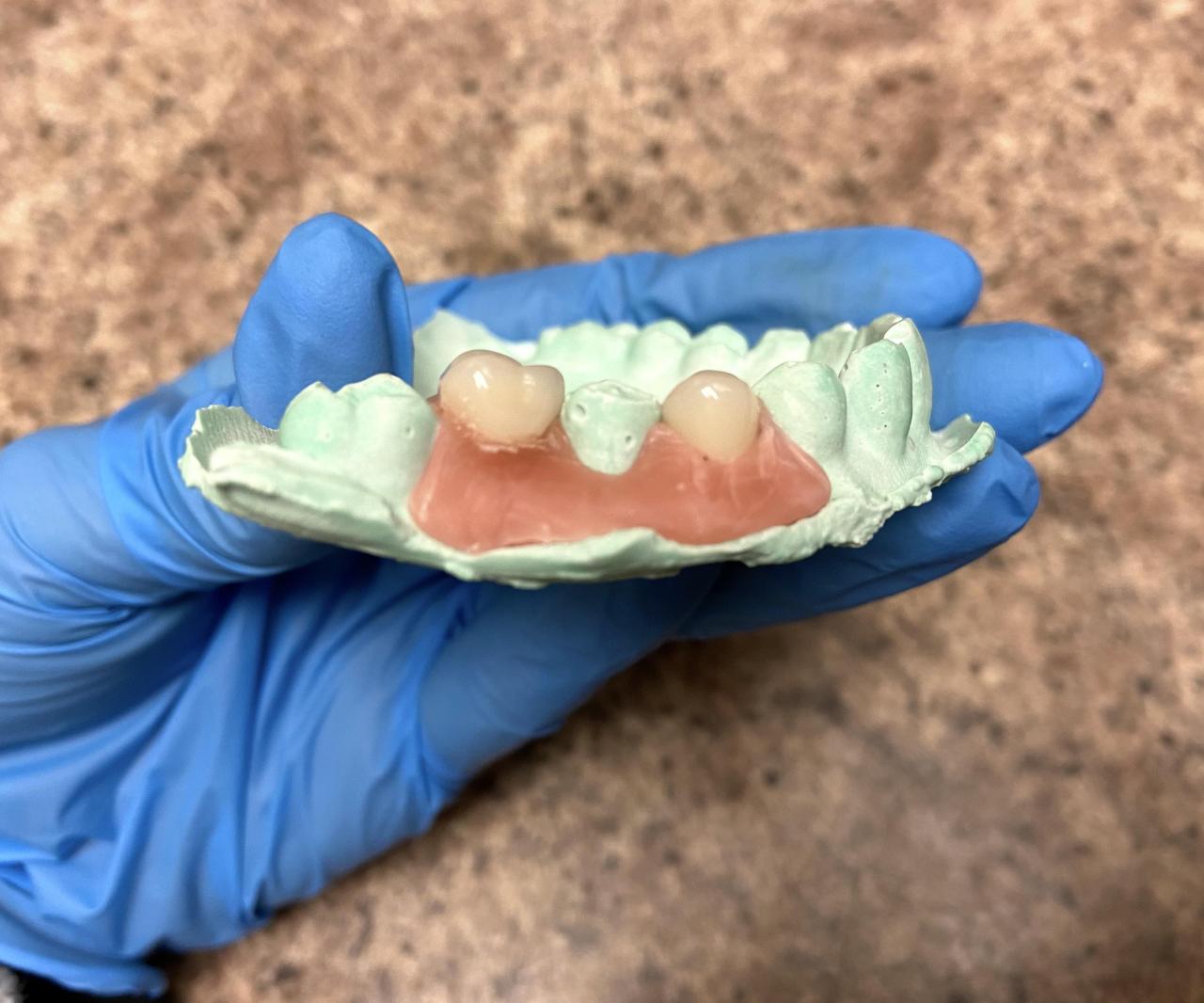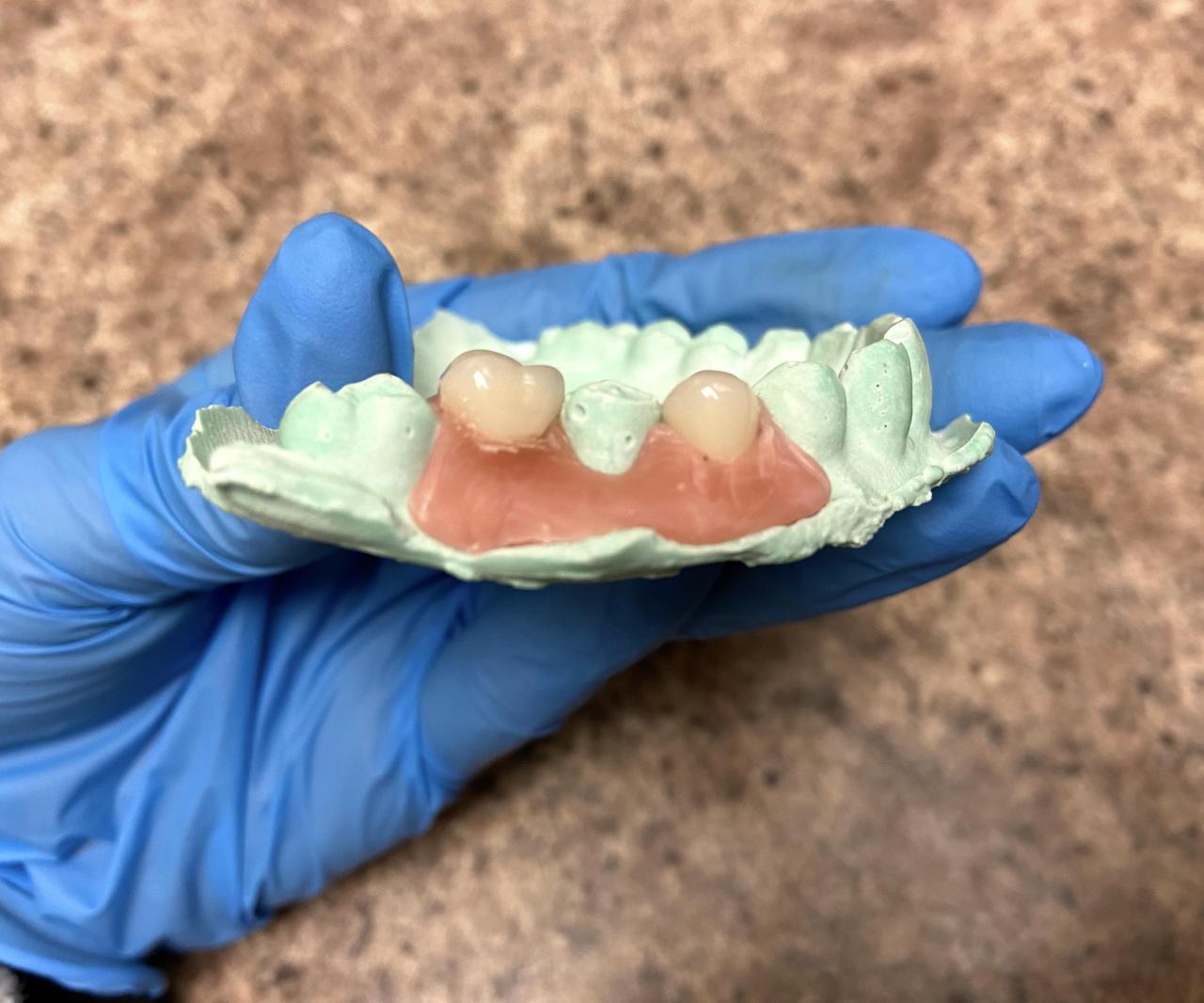DIY partial denture kits offer an accessible and potentially cost-effective solution for individuals seeking to replace missing teeth. These kits provide the tools and materials necessary to create a partial denture at home, promising a convenient alternative to professional dental services. However, it’s essential to approach DIY dentures with caution, as they may not always provide the same level of fit, functionality, and oral health benefits as professionally made dentures.
This guide delves into the world of DIY partial denture kits, exploring their benefits, drawbacks, and considerations for safe and effective use. We’ll cover the components of a typical kit, discuss the different types available, and provide step-by-step instructions for using a DIY kit. Additionally, we’ll address the importance of consulting a dental professional for proper fit, oral health guidance, and to determine if a DIY kit is the right option for your specific needs.
What is a DIY Partial Denture Kit?
A DIY partial denture kit is a collection of materials and tools designed to allow individuals to create their own partial dentures at home. These kits are typically marketed as a more affordable alternative to visiting a dentist for a traditional partial denture.
These kits aim to empower individuals to take control of their oral health and dental care by offering a convenient and potentially cost-effective solution for missing teeth.
Components of a DIY Partial Denture Kit
DIY partial denture kits usually contain a range of components, including:
- Impression material: This is a soft, moldable material used to create a precise replica of the user’s mouth and remaining teeth.
- Denture base material: This material, often acrylic or thermoplastic, forms the foundation of the partial denture.
- Artificial teeth: These are typically made of acrylic or porcelain and are designed to match the user’s natural teeth in size, shape, and color.
- Clamps or clasps: These are used to secure the partial denture to the remaining teeth.
- Instructions and tools: Kits often include detailed instructions, along with tools such as a mixing bowl, spatula, and measuring spoons, to guide users through the denture creation process.
Intended Use and Target Audience
DIY partial denture kits are primarily intended for individuals with missing teeth who are seeking a more affordable and accessible solution for dental restoration. The target audience may include:
- Individuals with limited financial resources: The cost of traditional partial dentures can be significant, making DIY kits a potentially attractive option for those with budget constraints.
- Individuals with limited access to dental care: In areas with limited dental services or long wait times, DIY kits might offer a faster and more convenient solution.
- Individuals seeking temporary solutions: These kits can provide a temporary solution for missing teeth while individuals save for a more permanent solution, such as a traditional partial denture or dental implants.
Choosing the Right DIY Kit

Making a DIY partial denture can seem daunting, but choosing the right kit can make the process much smoother. There are a variety of kits available, each with its own features and benefits. This section will guide you through the different types of DIY kits and help you choose the one that best suits your needs.
Types of DIY Partial Denture Kits
The most common types of DIY partial denture kits available are:
- Impression Kits: These kits allow you to take a mold of your mouth at home. They usually come with a tray, impression material, and instructions. You can then send the impression to a lab to create your partial denture.
- Pre-made Kits: These kits offer a more streamlined approach. They come with a pre-made partial denture that you can adjust to fit your mouth. You may need to use tools like a heat gun or a moldable material to customize the fit.
- Partial Denture Repair Kits: These kits are designed to repair existing partial dentures. They usually include materials like denture adhesive, repair resin, and instructions.
Factors to Consider When Choosing a Kit
Here are some important factors to consider when choosing a DIY partial denture kit:
- Material: Partial dentures can be made from a variety of materials, such as acrylic, nylon, or metal. Acrylic is the most common material and is known for its affordability and durability. Nylon is more flexible and can be a good option for people with sensitive gums. Metal partial dentures are the most durable and can last for many years.
- Size and Fit: It is important to choose a kit that is the right size for your mouth. You should also consider the number of teeth that need to be replaced. Some kits are designed for specific tooth counts.
- Features: Some kits come with additional features, such as denture adhesive, cleaning tablets, or a carrying case. These features can be helpful, but they are not always necessary.
Recommendations for Choosing a Kit
- For a new partial denture: If you are looking to replace multiple teeth, an impression kit is generally the best option. It allows for a more precise fit and ensures that the denture is made to your exact specifications.
- For a single missing tooth: If you are only missing one tooth, a pre-made kit might be a good option. It is less expensive and can be a quicker solution. However, you may need to adjust the fit to ensure it sits comfortably.
- For a broken or damaged denture: A denture repair kit is a convenient option for fixing a broken or damaged partial denture. However, if the damage is extensive, you may need to have your denture repaired by a professional.
DIY Partial Denture Kits vs. Professional Dentures
Deciding between a DIY partial denture kit and a professionally made denture is a crucial step in your journey towards restoring your smile. Both options offer unique advantages and disadvantages, and the best choice depends on your individual needs and circumstances.
This section compares and contrasts these two options, highlighting their respective strengths and weaknesses to help you make an informed decision.
Advantages and Disadvantages of DIY Partial Denture Kits
DIY partial denture kits offer convenience and affordability, allowing you to create a denture at home without the need for multiple appointments with a dentist. However, they also come with certain limitations.
- Advantages:
- Cost-effective: DIY kits are significantly cheaper than professional dentures, making them an attractive option for budget-conscious individuals.
- Convenience: You can create the denture at your own pace and avoid multiple trips to the dentist.
- Privacy: Some people may feel more comfortable creating a denture at home, especially if they have concerns about their oral health.
- Disadvantages:
- Limited customization: DIY kits offer less customization compared to professional dentures, which can lead to a less comfortable or aesthetically pleasing fit.
- Accuracy: Creating a precise denture at home can be challenging, potentially resulting in a poorly fitting denture that can cause discomfort or even damage your remaining teeth.
- Material quality: The materials used in DIY kits may not be as durable or biocompatible as those used in professional dentures, potentially leading to faster wear and tear or allergic reactions.
- Lack of professional guidance: You won’t have the benefit of a dentist’s expertise to ensure proper fit, bite alignment, and oral health maintenance.
Advantages and Disadvantages of Professional Dentures
Professional dentures, created by a qualified dentist, offer a higher level of customization, accuracy, and durability. However, they come at a higher cost and require multiple appointments.
- Advantages:
- Custom fit: Professional dentures are meticulously crafted to fit your mouth perfectly, ensuring comfort and stability.
- Precise bite alignment: Dentists carefully adjust the bite to ensure proper function and prevent jaw pain or discomfort.
- Durable materials: Professional dentures use high-quality materials designed for longevity and biocompatibility.
- Expert guidance: You receive comprehensive care from a dentist, including oral health advice, denture maintenance instructions, and follow-up appointments.
- Disadvantages:
- Higher cost: Professional dentures are significantly more expensive than DIY kits.
- Multiple appointments: Creating a professional denture requires several visits to the dentist.
When to Choose a Professional Denture
Professional dentures are generally recommended in the following situations:
- Complex cases: If you have multiple missing teeth or a complex dental history, a professional denture is likely the best option to ensure a comfortable and functional fit.
- Aesthetic concerns: If you’re concerned about the appearance of your denture, a professional can create a custom-made denture that blends seamlessly with your natural teeth.
- Oral health issues: If you have underlying oral health conditions, a dentist can address them and ensure your denture is properly fitted and maintained.
- Long-term solution: If you’re looking for a durable and long-lasting denture, a professional denture is the more reliable choice.
DIY Partial Denture Kits: Legal Considerations
Creating and using DIY partial denture kits raises several legal questions, primarily concerning the safety and efficacy of these products. It’s crucial to understand the legal implications associated with selling and using these kits to ensure compliance with regulations and avoid potential liability issues.
Legal Implications of Selling DIY Partial Denture Kits
The legality of selling DIY partial denture kits varies depending on the specific laws and regulations of each country or region. In some jurisdictions, selling these kits may be considered illegal if they are deemed to be medical devices requiring regulatory approval.
- For example, in the United States, the Food and Drug Administration (FDA) regulates medical devices, including dentures. The FDA classifies dentures as Class II medical devices, requiring premarket notification (510(k)) before they can be sold.
- This means that manufacturers of DIY partial denture kits would need to demonstrate that their kits are safe and effective for their intended use and meet specific performance standards.
Failure to comply with these regulations could result in legal action, including fines, product recalls, and even criminal charges.
Potential Liability Issues Associated with DIY Dentures
Individuals who sell or manufacture DIY partial denture kits could face significant liability if users experience adverse health effects or injuries due to the use of these kits.
- For example, if a user experiences an allergic reaction to the materials used in the kit, or if the denture is poorly fitted and causes damage to their gums or teeth, the manufacturer or seller could be held liable for negligence or product liability.
This liability could extend to individuals who provide instructions or guidance on using the kits, even if they are not directly involved in the manufacturing or sale of the kits.
Relevant Regulations and Consumer Protection Laws
Various regulations and consumer protection laws are relevant to the sale and use of DIY partial denture kits.
- For instance, in the United States, the Consumer Product Safety Commission (CPSC) is responsible for ensuring the safety of consumer products, including medical devices. The CPSC has the authority to recall products that pose a safety hazard.
- Additionally, state laws regarding consumer protection and product liability may apply to DIY partial denture kits.
It is essential for individuals involved in the sale or manufacture of these kits to be aware of and comply with all applicable regulations and laws to avoid legal consequences.
DIY Partial Denture Kits: Future Trends

The DIY partial denture kit market is poised for significant growth in the coming years, driven by factors such as increasing affordability, convenience, and the growing demand for dental care. This growth is expected to be fueled by advancements in materials, technology, and design, leading to more innovative and accessible solutions for individuals seeking partial dentures.
Advancements in Materials
The development of new materials is expected to play a crucial role in shaping the future of DIY partial denture kits. These advancements will focus on enhancing the durability, aesthetics, and biocompatibility of the materials used.
- High-Performance Polymers: Next-generation polymers with enhanced strength, flexibility, and resilience are likely to replace traditional acrylics, offering improved comfort and longevity. For example, thermoplastic polymers are already being explored for their ability to be molded and reshaped multiple times, allowing for easier adjustments and repairs.
- Biocompatible Ceramics: Ceramic materials are gaining traction in dental applications due to their excellent biocompatibility, durability, and aesthetic appeal. Advancements in ceramic processing techniques, such as 3D printing, are enabling the creation of customized ceramic partial dentures with intricate designs and natural-looking finishes.
- Metal Alloys: Metal alloys, particularly those with high strength-to-weight ratios and corrosion resistance, will continue to be used in DIY kits. Research is focused on developing alloys with improved biocompatibility and aesthetics, allowing for more natural-looking and comfortable partial dentures.
Technological Advancements
Technological advancements will revolutionize the design, fabrication, and fitting of DIY partial dentures. These innovations will enable greater customization, precision, and ease of use.
- 3D Printing: 3D printing technology is rapidly transforming the dental industry, allowing for the creation of highly customized partial dentures with complex geometries. This technology will enable DIY kits to offer personalized solutions based on individual patient needs, ensuring a perfect fit and enhanced comfort.
- Virtual Reality (VR) and Augmented Reality (AR): VR and AR technologies are poised to enhance the user experience by providing virtual try-on options, allowing individuals to visualize how different partial denture designs would look before committing to a purchase. This technology can also be used to guide users through the fitting process, ensuring accurate placement and optimal comfort.
- Artificial Intelligence (AI): AI algorithms can analyze dental scans and images to create personalized partial denture designs, reducing the need for multiple visits to a dentist. AI-powered kits can also offer virtual consultations and support, providing users with guidance and information throughout the process.
Design Innovations
The design of DIY partial denture kits will evolve to address user needs and preferences. This will involve incorporating features that enhance comfort, stability, and aesthetics.
- Improved Retention Mechanisms: Future DIY kits will incorporate innovative retention mechanisms, such as magnetic clasps or implant-supported attachments, providing a more secure and comfortable fit. These advancements will reduce the risk of dentures slipping or becoming dislodged during eating or speaking.
- Enhanced Aesthetics: DIY kits will offer a wider range of colors, shapes, and textures, allowing individuals to choose designs that complement their natural teeth and smile. This focus on aesthetics will improve confidence and self-esteem among users.
- Modular Designs: Modular designs will allow users to customize their partial dentures by adding or removing components as needed. This flexibility will enable individuals to adjust their dentures to accommodate changes in their dental needs over time.
Impact on the Dental Industry and Consumer Choices
The increasing availability and accessibility of DIY partial denture kits are likely to have a significant impact on the dental industry and consumer choices.
- Increased Competition: The emergence of DIY kits will create increased competition in the dental market, potentially leading to lower prices and greater innovation among traditional dental providers.
- Empowerment of Consumers: DIY kits empower consumers by giving them greater control over their dental care. Individuals will have more options for addressing their dental needs, potentially reducing their reliance on traditional dental services.
- Shifting Consumer Preferences: As DIY kits become more sophisticated and user-friendly, consumers are likely to embrace these options, leading to a shift in preferences towards convenient and affordable solutions.
DIY partial denture kits can be a viable option for some individuals, offering convenience and potential cost savings. However, it’s crucial to weigh the potential benefits against the risks and understand the limitations of these kits. Consulting a dental professional is highly recommended to ensure proper fit, oral health, and to determine if a DIY kit is suitable for your specific situation. Ultimately, informed decision-making and prioritizing oral health are paramount when considering any denture solution, whether DIY or professionally made.
DIY partial denture kits can be a great option for those looking to save money on dental care, but they can also be quite challenging to use. If you’re looking for a more hands-on project, you might enjoy building a set of monkey bars for your backyard, which can be a fun and rewarding experience. Monkey bars DIY projects often involve cutting and welding metal, skills that can be helpful when working with a DIY partial denture kit.
However, it’s important to remember that dentures are a critical part of oral health and should only be handled by qualified professionals.

